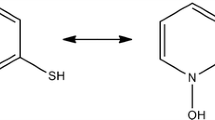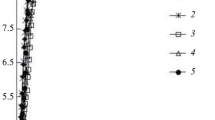Abstract
Various water-pyridine mixtures have been selected in order to compare several of the most popular extrathermodynamic assumptions involved in the determination of the transfer activity coefficient of the proton, γt(H+). Two techniques have been utilized for this purpose: voltammetry [study of the ferrocene, ferricyanide, or thallium(1) systems] and potentiometry at equilibrium (emf measurements of various galvanic cells, including liquid junctions and hydrogen electrode or silver electrode as a test electrode). The assumptions have been classified into various groups [e.g., γt(Zp+)=γt(Zq+) or γt(X−)=γt(Y+)], and the values of γt(H+) have been experimentally determined in each case. The results vary depending upon the basic assumption (several pH units); less important differences (e.g., 0.5 pH unit) occur within a given group, and this may be assigned to the nature of the reference species chosen. A simple model of solvation has been also examined; the application of the law of mass action to the corresponding equilibrium provides results close to the γt(X−) =γt(Y+)type of assumptions which ultimately leads to most self-consistent results.
Similar content being viewed by others
References
R. Alexander, A. J. Parker, J. H. Sharp, and W. E. Waghorne,J. Am. Chem. Soc. 94, 1148 (1972).
B. G. Cox, A. J. Parker, and W. E. Waghorne,J. Am. Chem. Soc. 95, 1010 (1973);
J. W. Diggle and A. J. Parker,Electrochim. Acta 18, 1973 (1975).
I. M. Kolthoff and M. K. Chatooni,J. Phys. Chem. 76, 2024 (1972).
J. L. Brisset, R. Gaboriaud, and R. Schaal,J. Phys. Chem. 68, 1506 (1971).
R. Gaboriaud,C. R. Acad. Sci. 270C, 1925 (1970);
R. Gaboriaud,J. Chim. Phys. 66, 10 (1969).
V. A. Pleskov,Zh. Fiz. Khim. 22, 351 (1948).
O. Popovych,Crit. Rev. Anal. Chem. 1, 73 (1970).
H. Strehlow, inThe Chemistry of Nonaqueous Solvents, J. J. Lagowski, ed. (Academic Press, New York, 1966).
J. Lelievre, C. Le Feuvre, and R. Gaboriaud,C. R. Acad. Sci. 275C, 1455 (1972);
J. Lelievre, work in progress.
I. M. Kolthoff and F. G. Thomas,J. Phys. Chem. 69, 3049 (1965).
W. R. Turner and P. J. Elving,Anal. Chem. 37, 467 (1965).
J. L. Brisset,J. Electroanal. Chem. 51, 133 (1974).
R. Gaboriaud,Ann. Chim. 2, 201 (1967);
R. Gaboriaud,J. Chim. Phys. 65, 1115 (1968);
R. Gaboriaud,Bull. Soc. Chim., 347 (1975).
A. Cisak and P. J. Elving,J. Electrochem. Soc. 110, 160 (1963).
L. M. Mukherjee,J. Phys. Chem. 76, 243 (1972).
M. Alfenaar,J. Phys. Chem. 79, 2200 (1975).
Author information
Authors and Affiliations
Rights and permissions
About this article
Cite this article
Brisset, JL. Transfer activity coefficient of the proton in water-pyridine mixtures. A comparison of some extrathermodynamic assumptions. J Solution Chem 5, 587–604 (1976). https://doi.org/10.1007/BF00647380
Received:
Revised:
Issue Date:
DOI: https://doi.org/10.1007/BF00647380




